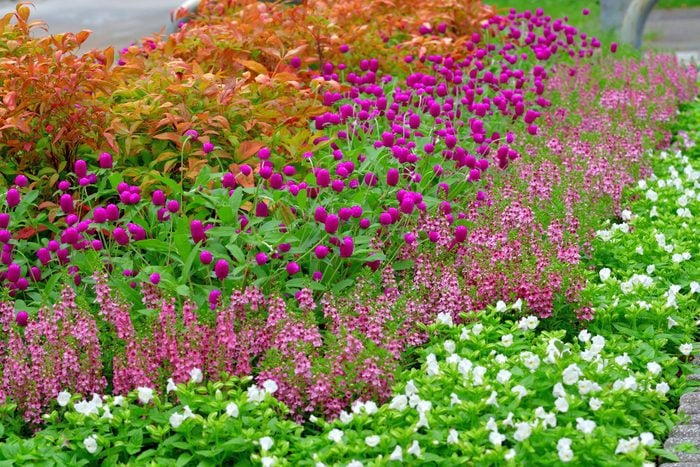Dress up your sunny patio and landscape with any of these dazzling annual flowers that thrive in sun and heat.
12 Best Annual Flowers for Full Sun
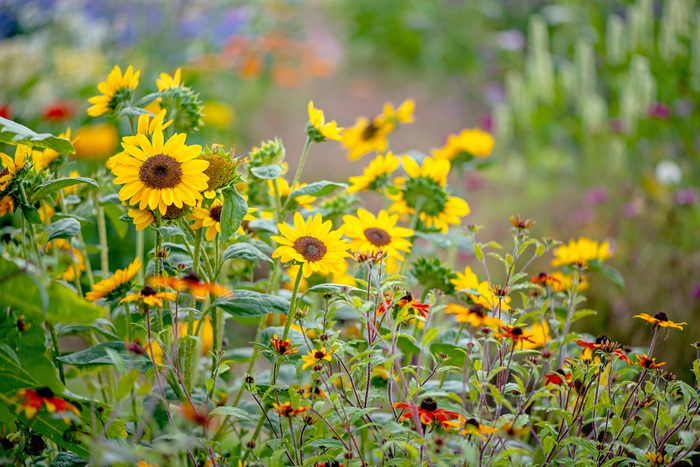
Sunflowers
Nothing says summer quite like sunflowers. They come in multiple varieties and turn their heads towards the sun as it moves from east to west.
Shorter plants grow easily in the shadow of sunflowers, which tower over them in vegetable gardens and flower borders. Sunflowers look best when planted in large groups. In fall, harvest the seeds from each flower head for eating toasted or dried for trail mix.
Traditionally, sunflowers are grown from seeds planted in the spring. Look for newer varieties of multiflora sunflowers like Suncredible, sold as potted plants at garden centers in the spring. They produce smaller but far more plentiful flowers on two- to three-foot-tall plants from early summer until frost.
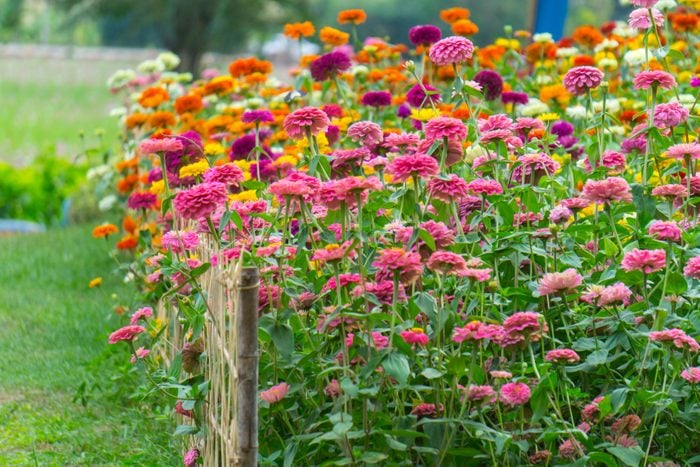
Zinnias
Blooming in every shade of the rainbow except blue, these cheerful summer annuals are perfect for filling the middle of the border or pairing with perennials for all summer color. Zinnias are long-lasting in bouquets. The more you cut, the more flowers they produce.
In the garden, you’re more likely to see butterflies dancing about taller zinnias that grow about waist-high. Varieties in the Zesty and Benary Giant series bear fluffy, double flowers on long stems that are great for cutting. There are also single-flowered cultivars like Profusion zinnias which grow just six inches tall with more of a low, spreading habit.
Powdery mildew can be an issue, so leave some space between plants to allow for good airflow. Avoid overhead watering after noon.
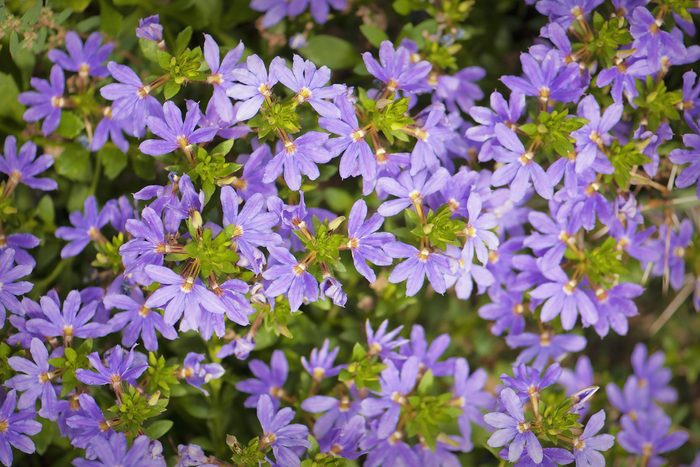
Fan Flower
Named for its fan-shaped arrangement of flower petals, this annual bears hundreds of small blooms in shades of blue, pink or white. Its unbranched stems mostly trail over time. But if used in combination with other types of flowers in containers, you will find them poking in and among their neighbors in every direction.
Fan flower (Scaevola) is a heat- and drought-tolerant, low-maintenance annual that grows beautifully as a temporary ground cover. It’ll also work nicely in combinations for hanging baskets and upright patio pots. For best growth, use well-drained soil and let the plant dry out between waterings.
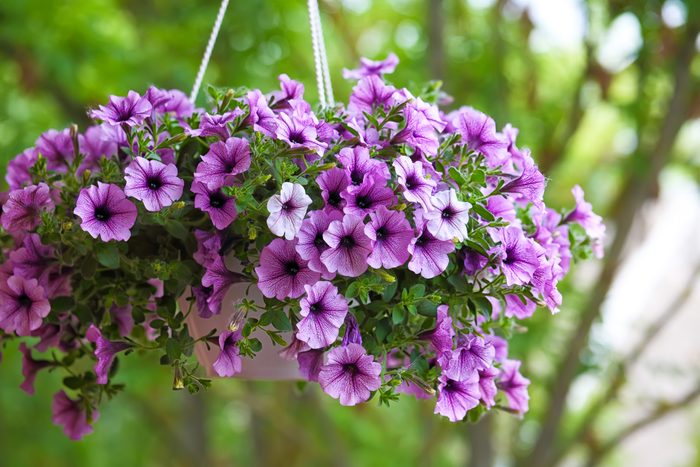
Petunia
This is one of the most versatile annuals for sun. Its colorful blossoms line the trailing stems, with new flowers opening daily from spring into fall.
You’ll find petunias in nearly every color of the rainbow as well as patterned and double selections. No matter which you grow, expect them to quickly scramble to cover several square feet in the landscape or spill from hanging baskets, window boxes or patio pots. Supertunia Vista and Wave petunias are particularly wide-spreading.
Look for self-cleaning varieties, or plan on spending your summer pinching off the spent flowers to keep your petunias blooming. Weekly feeding with water-soluble plant food is also important — these are some of the hungriest annuals you can grow. Find out if petunias are perennial.
In midsummer, trim all the stems back by one-quarter. That will encourage fresh growth and a new round of blooms that will last until fall.
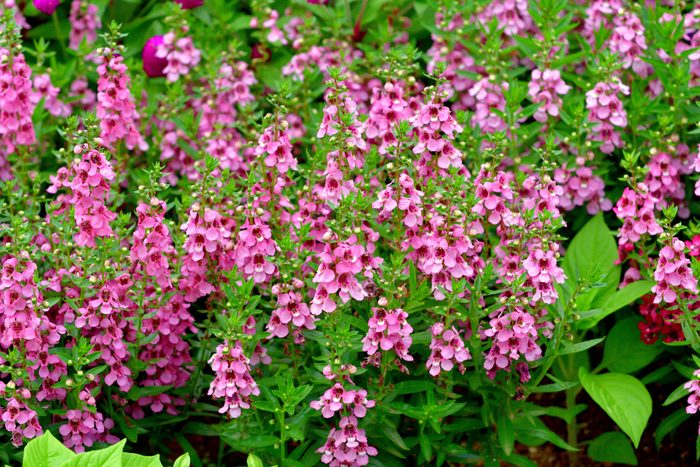
Angelonia
If you live in a climate with steamy hot summers and can’t find plants that handle it well, try Angelonia, also known as summer snapdragon. It needs heat to activate its growth. In cooler climates, it’s better to wait until late spring or early summer to plant them so they aren’t overrun by other annuals in combinations.
Typically, Angelonia is the taller centerpiece in the center of a container surrounded by trailing plants like petunias and calibrachoa. In the landscape, it works as a vertical, spiky element in contrast to neighboring mounded plants.
Varieties like Angelface Super Blue can grow up to 40 inches tall in a single season. Look for Angelonia blooming in shades of pink, blue, purple and white at your local garden center.
You can also grow some other unusual flowers in your garden like- asters and toad lilies.
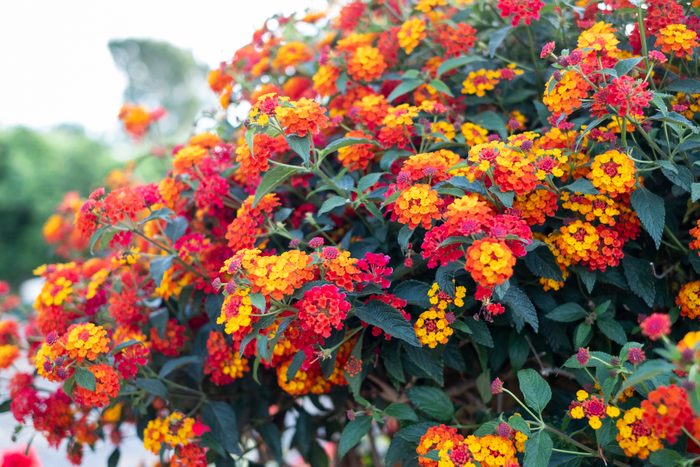
Lantana
If you live in the Deep South, you can grow lantana as a hardy shrub. But in most of the country, lantana is a durable annual that’s replanted each spring in large containers and landscapes.
Some varieties have a trailing habit, but most are bushy, upright plants that can reach up to two feet tall in a single season. Their intricately patterned, fragrant flower clusters draw in bees, butterflies and hummingbirds.
It’s important to look for varieties labeled as seedless or having a low seed set. Otherwise, the plant will need to be deadheaded so it doesn’t spread or stop blooming and go to seed partway through the summer. Once established, this durable, drought-tolerant annual requires little supplemental water or fertilizer to stay happy and healthy.
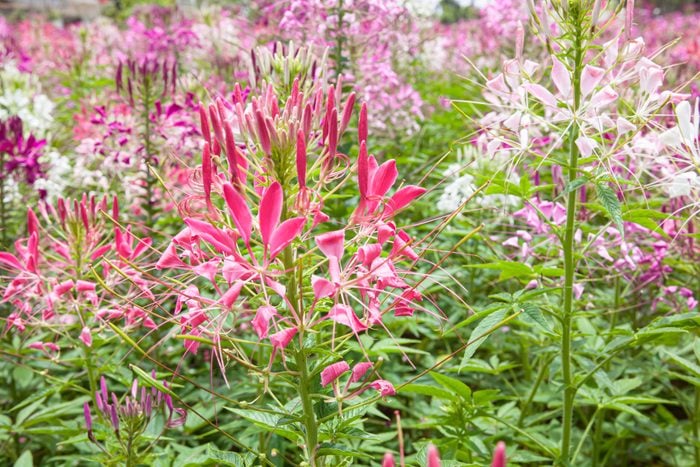
Cleome
For a different look in your sunniest garden spaces, plant cleome. Its uniquely shaped blossoms inspired nicknames like spider flower and cat’s whiskers. As the stems elongate, more flowers form from bottom to top, leaving beanlike seed pods in place of the spent flowers. You can save and dry the seeds for planting next year.
Cleome can easily reach three to four feet tall, with its stems mostly unbranched. That structure lends itself better to growing in the landscape than in containers. Plant at least three to five together in a clump for best impact. Cleome can be started from seed or grown from young plant starts in the spring.
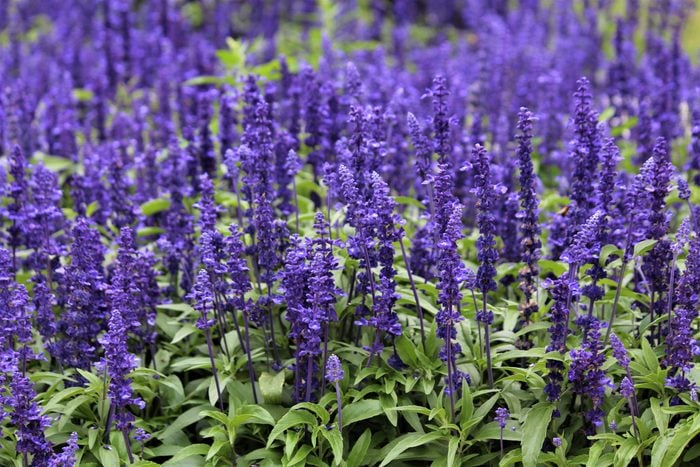
Salvia
Salvia is a large group of plants that includes annual and perennial varieties. The plant label will indicate whether the plant works in your USDA Plant Hardiness Zone. If you’re looking to attract pollinators and hummingbirds to your garden, any type of salvia is a great choice. And because its foliage gives off an herbal scent, rabbits and deer usually don’t like it.
Find a spot that receives at least six hours of sun to see the most prolific blooms and strong growth. Taller varieties of salvia like ‘Black and Blue’ are best planted in the landscape because they can grow two to four feet tall and equally wide. Shorter ones like ‘Hummingbird Falls’ are fun to grow in patio pots to draw hummingbirds in close.
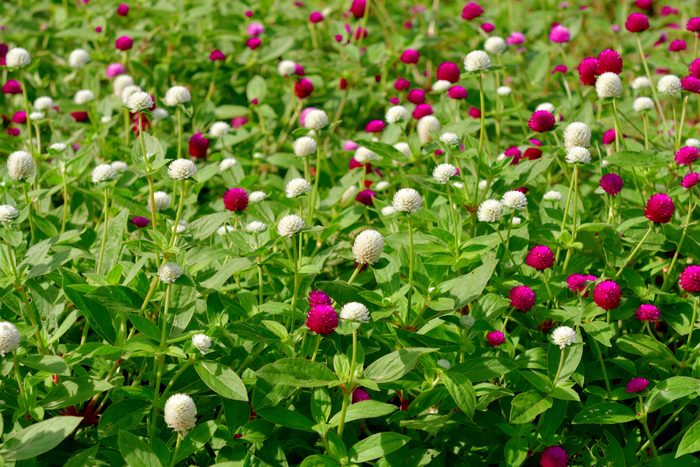
Globe Amaranth
Add some whimsy to your garden and containers with globe amaranth (Gomphrena). Its papery textured, globe-shaped blooms are held upright like little lollipops on strong stems.
Depending on which type you plant, it could grow eight inches or three feet tall, so read the tag carefully when choosing the best one to fit your space. Plant a few extra for cutting because these unique flowers stay the same color whether fresh or dried. You’ll find them in shades of purple, pink, red and white.
Globe amaranth is a durable annual that handles heat and drought well. Give it some elbow room when planting companions nearby to allow for good airflow and prevent powdery mildew. Well-drained soil is essential for its continued good health.
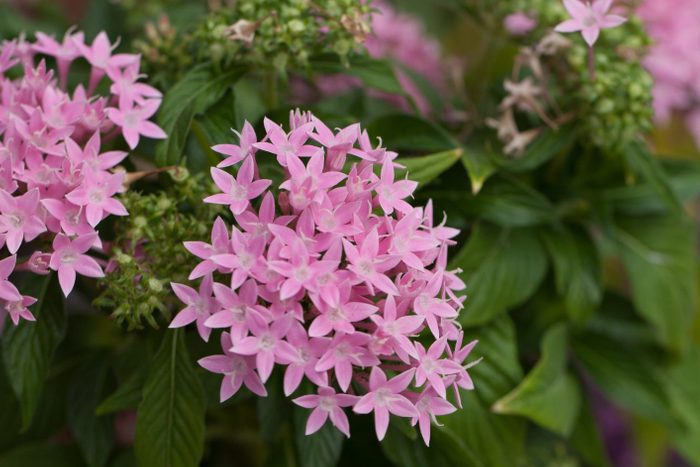
Pentas
Thriving in heat and humidity, pentas are commonly grown as perennials in tropical climates like Florida. In USDA Zones 8 and colder, they’re grown as annuals in containers and garden beds.
You’re sure to see butterflies and hummingbirds when you plant these pink, red, lavender and white blooms. Tightly packed clusters of star-shaped flowers top the 18- to 26-inch-tall plants from early summer to frost. Look for Sunstar pentas with particularly large flower clusters, nearly the size of hydrangeas.
Pentas will grow in nearly any soil with decent drainage, including alkaline. Mulch around their shallow roots to keep the soil cool and moist. No deadheading is needed for continuous bloom, but feeding once per month with water-soluble plant food will keep them growing strong.
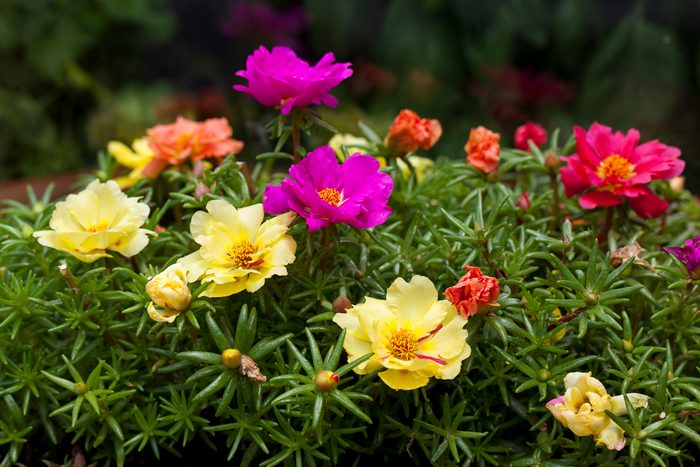
Moss Rose
If you live where summers tend to be hot and dry, moss rose (Portulaca) is perfect for the sunniest parts of your landscape. This flowering succulent is virtually carefree once established, blooming non-stop without deadheading all season.
You’ll find single and double-flowered varieties in mixed colors or single shades of red, magenta, pink, orange and yellow. Bees often visit on sunny afternoons, but the flowers close up at night and on rainy days.
Rock gardens, troughs and rocky outcroppings are all good places to sow seeds of low-growing moss roses. They appreciate the sharply drained soil as their shallow roots will easily rot if planted in heavy soil. No fertilizer is needed to keep the flowers coming.
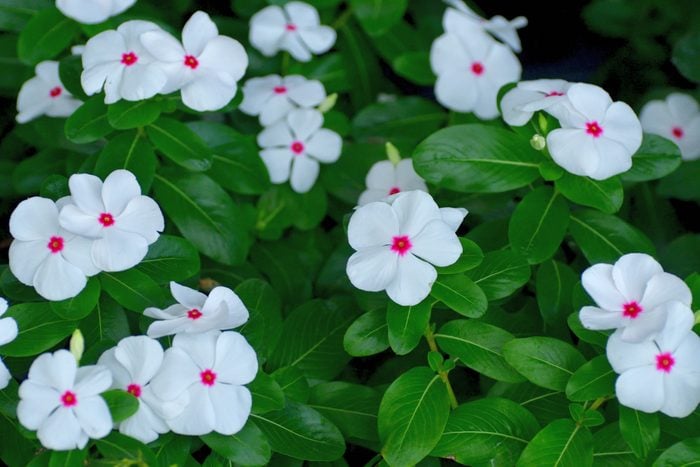
Vinca
Here’s a sun-loving annual that’s easy to confuse with a close lookalike: bedding impatiens. The two prefer exactly opposite growing conditions, so check the labels carefully to be sure you’re buying vinca (Catharanthus).
Vinca’s dark-green leaves are glossy, and its stems aren’t fleshy like impatiens. It needs lots of sun and heat (but not a lot of water) to thrive and bloom non-stop from early summer to frost. Butterflies are frequent visitors, but deer and rabbits usually leave it alone.
Vinca is typically planted en masse to fill the front of garden beds where it grows six to 12 inches tall. Its five-petaled blossoms come in shades of pink, lavender, red and white, often with an eye of a contrasting color. Cora is a popular series known for its excellent disease resistance.





















